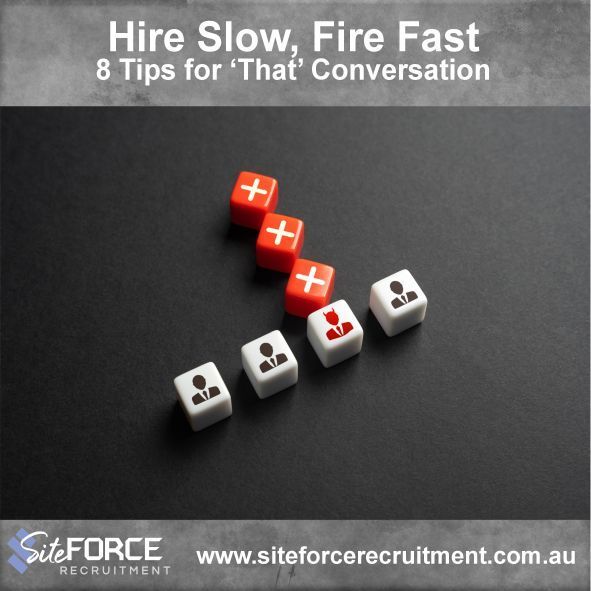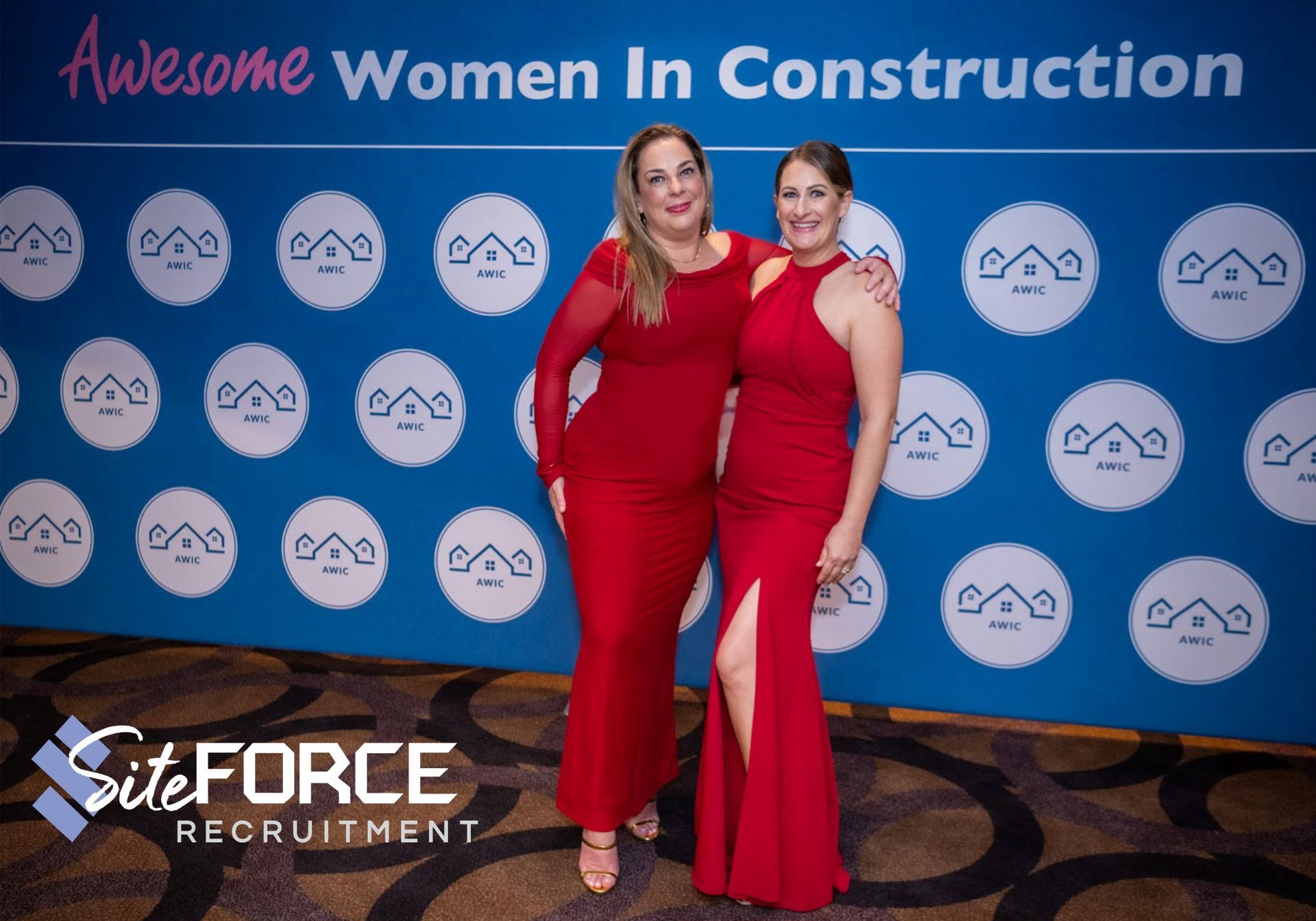HIRE SLOW, FIRE FAST
The Firing Process – 8 Tips for ‘That’ Conversation

In the construction industry, where time, costs, quality, safety, and precision are critical, hiring the right person for the job is essential. Yet, despite the best efforts, there are occasions you bring someone on board who just doesn’t fit.
When you know a new hire isn’t working out, you need to act quickly. The principle of “hiring slow, firing fast” helps avoid the long - term damage that a poor hire can cause to productivity, morale, and project outcomes.
In this article, we’ll discuss how to spot early warning signs that a hire isn’t working out, the importance of clear job descriptions, the legal aspects of firing, and how to approach these difficult conversations professionally with my 8 tips for how to have a successful “firing” conversation.
When You Know A Hire Is Not Working Out
As a business owner, you can often tell early on when a new hire just isn’t cutting it. Of course, every new hire needs to be given time to adjust, but there will be a point with a bad hire beyond that settling in time, when they might still be struggling to meet the demands of the job. It may be they fail to hit KPIs, don’t catch on to the tasks as expected, don’t mesh with the company’s culture, show little interest in the role or engaging with you or the team, there is a disregard for safety. standards or outcomes required by the company. These signs should never be ignored. They indicate a deeper issue, whether it’s a mismatch in skills or attitude, and delaying the decision to fire can prolong unnecessary stress for you and the team.
You may have hired them based on an impressive interview and a polished resume, but things like not being proactive, failing to communicate effectively, or consistently underperforming are red flags. When these issues arise, it’s critical to assess the situation quickly and take appropriate action before things get worse.
And sometimes you just know straight away, your decision wasn’t the best one.
The Power of a Clear Job Description
One of the most important steps in hiring slow is crafting a clear, detailed job description. Think of it as a “Job Description for Dummies” - clear enough that anyone can understand beyond the tasks and credentials, also the expectations, requirements, responsibilities, standards and outcomes expected as well as the personality and cultural fit needed for that particular position. This not only helps the employee know exactly what is expected of them but also serves as a reference point if you need to initiate the firing process.
It’s not uncommon for candidates to exaggerate their abilities or successes during the hiring process or to hide a personality trait that is undesirable in any workplace. They might present themselves as a perfect fit for the role, but once they’re in the job, the cracks start to show. A comprehensive job description protects you in these cases. If you find yourself needing to terminate an employee, you can point back to the specific expectations that were clearly outlined from the start.
Include everything in the job description – what the job entails, what success looks like, and just as importantly, what’s not part of the role – what are your ‘exclusions’ for this position. This way, if the employee isn’t performing or doing tasks outside of their responsibilities, you have clear documentation to justify your decision to let them go.
Firing According to Australian Legislation
In Australia, firing an employee must be done ‘by the book’ to avoid legal repercussions. Your first step is checking and meeting the legislation, the award if applicable, and your employment contract.
The Fair Work Act sets out a clear process for termination, which includes giving employees three formal warnings before dismissal can occur. This process ensures fairness and protects employers from claims of unfair dismissal. Each warning must be documented and should clearly outline the issues, giving the employee a reasonable opportunity to improve their performance or behaviour. Here’s a breakdown of what’s involved:
Three Formal Warnings: The Fair Work Act requires a structured approach when it comes to dismissing an employee. This includes issuing three written warnings over a reasonable period.
o First Warning: This is usually a verbal or written warning that addresses the problem. It should include constructive feedback and suggestions for improvement.
o Second Warning: If the issue continues, a second warning should follow. This time, it’s more formal and might include a performance improvement plan (PIP), which sets clear goals and timelines for improvement.
o Third Warning: The final warning indicates that if there’s no improvement, termination will be the next step. It’s important that by this stage, the employee understands the seriousness of the situation.
Documentation of Each Warning: Each step of the warning process must be documented. This documentation can serve as evidence if the termination is challenged. Ensure that:
o The issue is clearly explained.
o Specific examples of poor performance or misconduct are provided.
o The employee acknowledges receipt of each warning (ideally, in writing).
o Constructive feedback is given, and improvement expectations are clearly set out.
Clear Communication: It’s not enough to simply warn an employee—each warning should include:
o A description of the problem (e.g., not meeting KPIs, poor attendance, misconduct).
o Specific examples and data (if available) to back up your claims.
o Constructive feedback on how the employee can improve.
o A timeline for when improvement needs to be seen.
Opportunity to Improve: Giving the employee a genuine opportunity to improve is critical. This shows that as an employer, you’ve acted fairly. Include:
o A clear plan for improvement (e.g., a performance improvement plan).
o Additional training or resources, if necessary.
o Regular follow - ups to check progress.
Legal Justification for Termination: If, after three warnings, the employee’s performance hasn’t improved, you have legal grounds for termination. However, you need to know the legislation and make sure your employment contract aligns with this process to avoid any loopholes.
Customised Employment Contracts: Many businesses use standard contracts that might not suit their specific needs. These generic contracts can leave room for interpretation, potentially opening you up to disputes. Here’s why it’s worth investing in a lawyer - drafted contract:
o Tailored Terms: Every business is unique, and so are its needs. A customised contract reflects your specific terms and conditions.
o Clear Stipulations: Your contract can clearly outline what constitutes grounds for warnings and dismissal, reducing ambiguity.
o Legal Protection: A well - crafted contract ensures that all legal requirements are met and that you are fully protected in case of any claims of unfair dismissal.
Termination Grounds: The contract should define:
o What constitutes poor performance or misconduct.
o The conditions under which warnings will be issued.
o What is considered grounds for immediate dismissal (e.g., gross misconduct or serious safety breaches).
Following the Fair Work Act guidelines and ensuring your contracts are robust will protect your business from legal challenges. By providing warnings, documenting the process, and allowing employees to improve, you create a fair and transparent environment while maintaining the flexibility to remove those who aren’t meeting the business’s needs.
Consider Engaging a Labour Hire Company
One way to avoid the stress of hiring mistakes is by using a labour hire company, like SiteForce Recruitment. With both labour hire and permanent recruitment options, when you engage us to do your recruitment, you can “try before you buy.” This allows you to assess a worker’s performance on-site before committing to a permanent placement. If the fit isn’t right, you can move on without the complexities of direct hiring and firing processes.
We have many success stories of someone starting with us as a labour hire employ, that once placed with an employer, the employer has absolutely loved the person and what they bring to the table, and want to make it a permanent one and have offered that person a permanent role (and the candidate also has had an opportunity to see the fit with the new company is a good one for them as well).
Tips for Having the Tough Conversation
Firing someone is never easy, but it’s a necessary part of running a business. As uncomfortable as it may be, letting go of an employee who isn’t meeting the required standards is crucial for maintaining team morale, productivity, and ensuring the long - term success of your business. When it’s time to have that difficult conversation, thorough preparation is essential. The way you approach this conversation can either defuse a tense situation or escalate it, so it’s important to be calm, clear, and professional. The old way in construction has gone, and quality leadership and respect in our field is now required. A mismatch with a candidate for your company may be dream in another, so keep in mind candidates talk to each other. This skillset is essential for both your, and your company’s, reputation.
My 8 tips for this conversation are: -
1. Start with a Neutral and Clear Statement: Begin the conversation with a neutral, straightforward statement. This sets the tone and helps avoid unnecessary emotional escalation. Phrasing like, “This hasn’t worked out as we both expected,” or “This role hasn’t met our mutual expectations,” is a tactful way to start. By framing the situation as a mutual misalignment, you avoid placing blame and open the door for a more constructive conversation. This also signals to the employee that this is a professional decision, not a personal attack.
2. Avoid Emotional Language and Keep it Professional: It's crucial to avoid emotional language during the conversation. Keep the tone factual and avoid words that could make the employee feel personally attacked or demeaned. Instead of saying things like, “You’ve been a failure at this,” focus on specifics related to the role, such as, “You haven’t met the KPIs that were agreed upon” or “Your work hasn’t aligned with the expectations laid out in the job description.” Staying focused on measurable outcomes makes the conversation feel more objective and grounded in facts.
3. Reference the Job Description and Past Warnings: A well - documented process leading up to the termination will protect you legally and ensure the conversation stays on solid ground. Reference the job description or previous warnings when discussing the reasons for dismissal. This reinforces the fact that the employee was given a fair opportunity to meet the role’s requirements and that this decision is based on their documented performance, not personal biases or assumptions. For example, you might say, “As outlined in the job description, a core requirement of this role is meeting project deadlines, which hasn’t been consistently achieved,” or, “We discussed this during your second warning when we outlined the need for better team communication.”
4. Be Clear, Concise, and Don’t Drag Out the Conversation: Firing someone is already an emotional experience for both parties, and prolonging the conversation unnecessarily can make it even more uncomfortable. Be clear and concise - get to the point quickly while still being respectful. A long, drawn - out conversation can add confusion or make the employee feel like there’s still room for negotiation when the decision has already been made. Outline the reasons for termination, reference the previous warnings, and then move to the next steps, such as the exit process.
5. Allow for Moments of Silence: During difficult conversations, silence can feel awkward, but it serves a purpose. If there’s a pause after you’ve delivered the news, don’t rush to fill it. Silence gives the other person time to process what’s been said. It can also prevent emotional reactions from escalating, as the employee may need a few moments to collect their thoughts. Allowing silence shows that you’re giving them space to react and avoids the risk of overwhelming them with too much information at once.
6. Stay Calm if the Employee Becomes Emotional:
Emotions can run high during termination discussions. If the employee becomes emotional, whether that manifests as anger, frustration, or sadness, it’s important to remain composed. This situation is similar to dealing with a disgruntled customer - it requires patience, empathy, and the ability to stay calm under pressure. If the employee starts to raise their voice or become upset, acknowledge their feelings but bring the conversation back to the facts. You could say, “I understand this is difficult, but the decision is based on performance, not personal feelings.” Remaining calm will help de - escalate the situation and set the tone for a respectful, dignified end to the conversation.
7. Practice the Conversation Ahead of Time: If you’re nervous about the conversation, it can help to practice beforehand. Rehearse what you’re going to say, anticipate possible emotional responses, and think through how you’ll handle them. This preparation will not only make you feel more confident but also help the conversation flow more smoothly. The more prepared you are, the more likely you’ll be able to maintain a professional and empathetic tone, even if the conversation becomes difficult.
8. End the Conversation Respectfully: Once the conversation is nearing its conclusion, focus on wrapping things up respectfully. Be clear about what happens next, whether it’s a final paycheque, collecting personal belongings, or completing exit paperwork. Make sure the employee understands the next steps and offer any assistance they might need to transition out of the role. Even if the relationship is ending on a difficult note, leaving the conversation on a professional and respectful tone can make a big difference.
By preparing thoroughly, maintaining professionalism, and keeping the conversation focused on the facts, you can handle terminations in a way that protects both your business and the dignity of the employee.
Reviewing and Learning from the Experience
After the dust has settled, it’s worth taking the time to review what went wrong during the hiring process. Were you trying a DIY placement? Was the job description clear enough? Were the interviews thorough? Was there pressure to hire too quickly that something was missed? Did you overlook warning signs? Use this experience to refine your hiring process so that next time, you can avoid the same pitfalls.
Hiring slow and firing fast is not just a catchy phrase - it’s a strategy that can save you time, money, and frustration in the long run. By identifying poor hires early, relying on clear and concise job descriptions, following proper legal procedures, and learning from each experience, you’ll build a stronger, more effective team. And when in doubt, engaging a labour hire agency like SiteForce Recruitment can help you mitigate the risks and find the right fit without the hassle.
Our Superpower
Our leading 'superpower' is attracting and retaining quality team members who share our values of honesty, integrity, diligence, and service, allowing us to deploy quality team members on client sites quickly.
Our team member's superpower is being motivated, prepared and ready to enthusiastically contribute to the projects at hand, more than just a pair of hands.
Related articles:
Read other informative articles for both employers and workers at: https://www.siteforcerecruitment.com.au/blogs
Chantal Penny is the Director with Superpowers of SiteForce Recruitment. A thought leader in the industry, Chantal, based on her expertise and industry perspective, offers unique guidance, inspiration, and influence in the industry. Chantal Penny is also a thought leader in the industry with her Podcast, Talent Instinct, which is available at:
https://talentinstinctpodcast.libsyn.com/site
At SiteForce Recruitment, we specialise in labour-hire and permanent recruitment in the construction industry. We are committed to valuing people, safety and wellbeing, collaboration, trust and, of course – results!
CONNECT with us via our contact page or bookings links on our website if you are looking to recruit for, get your dream job, or join our amazing labour force team.











